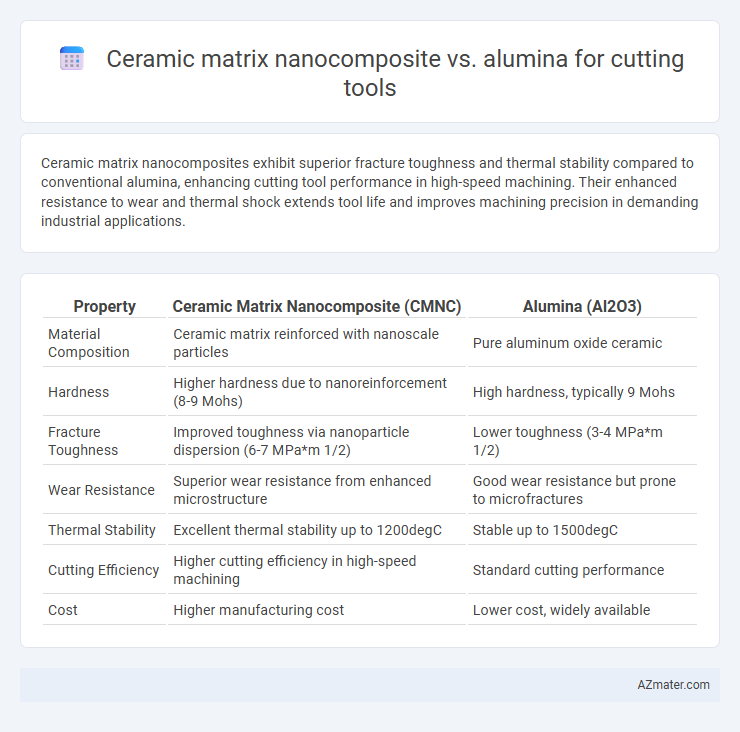Ceramic matrix nanocomposites exhibit superior fracture toughness and thermal stability compared to conventional alumina, enhancing cutting tool performance in high-speed machining. Their enhanced resistance to wear and thermal shock extends tool life and improves machining precision in demanding industrial applications.
Table of Comparison
| Property | Ceramic Matrix Nanocomposite (CMNC) | Alumina (Al2O3) |
|---|---|---|
| Material Composition | Ceramic matrix reinforced with nanoscale particles | Pure aluminum oxide ceramic |
| Hardness | Higher hardness due to nanoreinforcement (8-9 Mohs) | High hardness, typically 9 Mohs |
| Fracture Toughness | Improved toughness via nanoparticle dispersion (6-7 MPa*m 1/2) | Lower toughness (3-4 MPa*m 1/2) |
| Wear Resistance | Superior wear resistance from enhanced microstructure | Good wear resistance but prone to microfractures |
| Thermal Stability | Excellent thermal stability up to 1200degC | Stable up to 1500degC |
| Cutting Efficiency | Higher cutting efficiency in high-speed machining | Standard cutting performance |
| Cost | Higher manufacturing cost | Lower cost, widely available |
Introduction to Cutting Tool Materials
Cutting tool materials like ceramic matrix nanocomposites (CMNCs) and alumina play crucial roles in machining efficiency and tool life. CMNCs offer enhanced toughness and thermal stability due to their nanostructured reinforcements, outperforming conventional alumina in wear resistance and fracture toughness. Alumina remains widely used for its high hardness and chemical inertness, but CMNCs provide superior performance in high-speed cutting and abrasive conditions.
Overview of Ceramic Matrix Nanocomposites
Ceramic matrix nanocomposites (CMNCs) enhance cutting tool performance through the integration of nanoscale reinforcements within a ceramic matrix, providing superior hardness and fracture toughness compared to conventional alumina. These nanocomposites exhibit improved thermal stability and wear resistance, enabling higher cutting speeds and extended tool life in machining applications. The advanced microstructure of CMNCs allows for better control over crack propagation and mechanical strength, making them a promising alternative to traditional alumina-based tools.
Alumina: Properties and Applications
Alumina exhibits exceptional hardness, high wear resistance, and thermal stability, making it a preferred material for cutting tool applications. Its excellent electrical insulation and chemical inertness enable superior performance in high-speed machining and abrasive environments. Compared to ceramic matrix nanocomposites, alumina provides cost-effective durability and reliability for cutting tools in metalworking and machining industries.
Mechanical Strength Comparison
Ceramic matrix nanocomposites (CMNCs) exhibit significantly enhanced mechanical strength compared to traditional alumina cutting tools, due to their nanoscale reinforcement phases that inhibit crack propagation and improve toughness. While alumina offers high hardness and wear resistance, CMNCs provide superior fracture toughness and flexural strength, resulting in longer tool life and better performance under high-stress machining conditions. The incorporation of nanomaterials such as silicon carbide or carbon nanotubes within ceramic matrices elevates the mechanical properties beyond the capabilities of pure alumina-based tools.
Wear Resistance and Tool Life
Ceramic matrix nanocomposites exhibit superior wear resistance compared to conventional alumina cutting tools due to their enhanced fracture toughness and thermal stability, resulting from the nanoscale reinforcement phases that hinder crack propagation and abrasive wear. These nanocomposites maintain hardness and strength at elevated temperatures, significantly extending tool life under aggressive cutting conditions involving high speeds and hard materials. In contrast, alumina tools, while hard and chemically inert, are more prone to brittle fracture and rapid wear, limiting their tool life in demanding machining applications.
Thermal Stability and Conductivity
Ceramic matrix nanocomposites exhibit superior thermal stability compared to traditional alumina, maintaining structural integrity at temperatures exceeding 1400degC, which enhances cutting tool longevity during high-speed machining. Their tailored nano-reinforcements improve thermal conductivity, facilitating efficient heat dissipation and reducing thermal deformation under intense cutting conditions. In contrast, alumina's lower thermal conductivity and moderate thermal stability limit its performance in extreme thermal environments, making ceramic matrix nanocomposites a preferred material for advanced cutting tools requiring high thermal management.
Toughness and Fracture Resistance
Ceramic matrix nanocomposites exhibit superior toughness and fracture resistance compared to traditional alumina, owing to their enhanced grain boundary strength and crack deflection mechanisms provided by nanoscale reinforcements. Alumina, while highly wear-resistant, tends to suffer from brittleness and lower fracture toughness, limiting its performance under high-impact cutting conditions. The improved fracture toughness of ceramic matrix nanocomposites translates to longer tool life and better reliability in demanding machining applications.
Machining Performance Analysis
Ceramic matrix nanocomposites exhibit superior machining performance compared to traditional alumina cutting tools due to enhanced toughness and thermal stability, resulting in extended tool life and higher material removal rates. The incorporation of nanoscale reinforcements in ceramic matrices significantly improves wear resistance and reduces cutting forces during high-speed machining of hard materials. These advancements enable more efficient and precise cutting operations, particularly in demanding applications involving hardened steels and aerospace alloys.
Cost-Effectiveness and Industrial Adoption
Ceramic matrix nanocomposites (CMNCs) offer enhanced wear resistance and toughness compared to conventional alumina cutting tools, leading to longer tool life and reduced downtime in industrial applications. Although CMNCs have higher initial production costs due to advanced manufacturing techniques, their superior performance often results in lower total operational expenses, making them cost-effective for high-precision, high-speed machining. Industrial adoption of CMNCs is growing in sectors such as aerospace and automotive manufacturing, where the balance between upfront investment and performance gain justifies the transition from traditional alumina tools.
Future Trends in Cutting Tool Materials
Ceramic matrix nanocomposites (CMNCs) exhibit superior thermal stability, enhanced wear resistance, and improved fracture toughness compared to traditional alumina, making them ideal for next-generation cutting tool applications. Research trends emphasize the integration of nanoscale reinforcements in CMNCs to optimize mechanical properties and extend tool life under high-speed machining conditions. The future of cutting tool materials is moving towards hybrid composites combining alumina with nanoscale additives to achieve an optimal balance between hardness, toughness, and thermal conductivity.

Infographic: Ceramic matrix nanocomposite vs Alumina for Cutting tool
 azmater.com
azmater.com